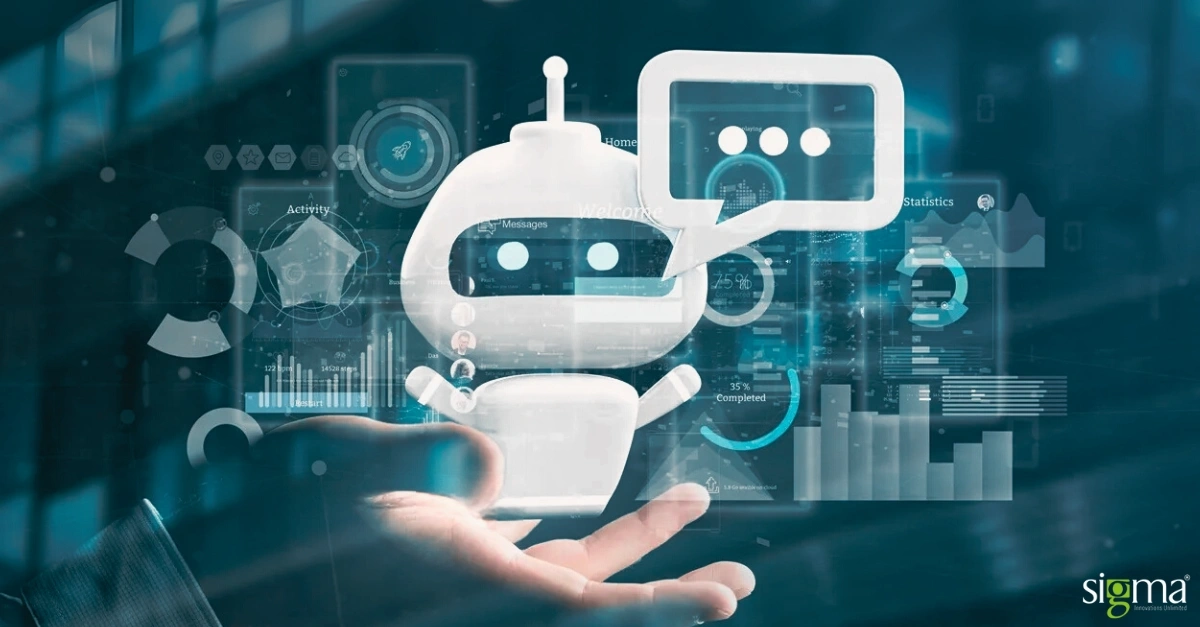How to Build an AI Chatbot: A Step-by-Step Guide
Key Highlights:
- Building an AI chatbot involves clear goal definition, designing natural conversational flows, selecting appropriate AI technologies, development, thorough testing, deployment, and continuous monitoring.
- AI chatbots leverage core technologies like Natural Language Processing (NLP) for understanding language, Machine Learning (ML) for improving responses, and Conversational AI for dynamic, context-aware interactions.
- Unlike traditional rule-based bots, AI chatbots use NLP, ML, and large language models to generate personalized, unscripted replies and handle complex queries effectively.
- Machine learning enables chatbots to learn from past interactions, adapt to user behavior, improve accuracy, and support multilingual and personalized conversations.
- Well-designed AI chatbots enhance customer support by instantly addressing common questions, freeing human agents for complex issues, thereby improving efficiency and customer satisfaction.
Building an AI chatbot begins with a clear plan and the right tools. Start by defining your chatbot’s purpose – whether it’s customer support, sales, or information delivery. Next, choose a development platform that fits your skill level and needs. Popular options include Botpress for open-source flexibility or platforms like Voiceflow for no-code solutions.
Follow these essential steps:
- Define chatbot goals and target users.
- Design conversational flows focusing on natural language understanding.
- Select your AI engine and technology stack (e.g., GPT-4, AWS Lex).
- Develop and train your chatbot with relevant datasets.
- Test thoroughly to refine responses.
- Deploy on your chosen channels (website, messaging apps).
- Monitor and update regularly for improvements.
This structured approach simplifies complexity and helps create a user-friendly, effective AI chatbot.
What are AI Chatbots, and What are their Core Technologies?
AI chatbots are software programs that simulate human-like conversations by leveraging core technologies like Natural Language Processing (NLP) and Machine Learning (ML). NLP enables chatbots to understand, interpret, and generate human language, making interactions feel natural and intuitive. Meanwhile, ML allows chatbots to learn from past conversations, improving their responses over time.
Key technologies powering AI chatbots include:
- Natural Language Processing (NLP): Breaks down user input to grasp intent and context.
- Machine Learning (ML): Enhances chatbot accuracy through data-driven learning.
- Conversational AI: Combines NLP and ML to enable dynamic, context-aware conversations.
These technologies work together to help chatbots respond accurately, handle complex queries, and continuously improve user experience.
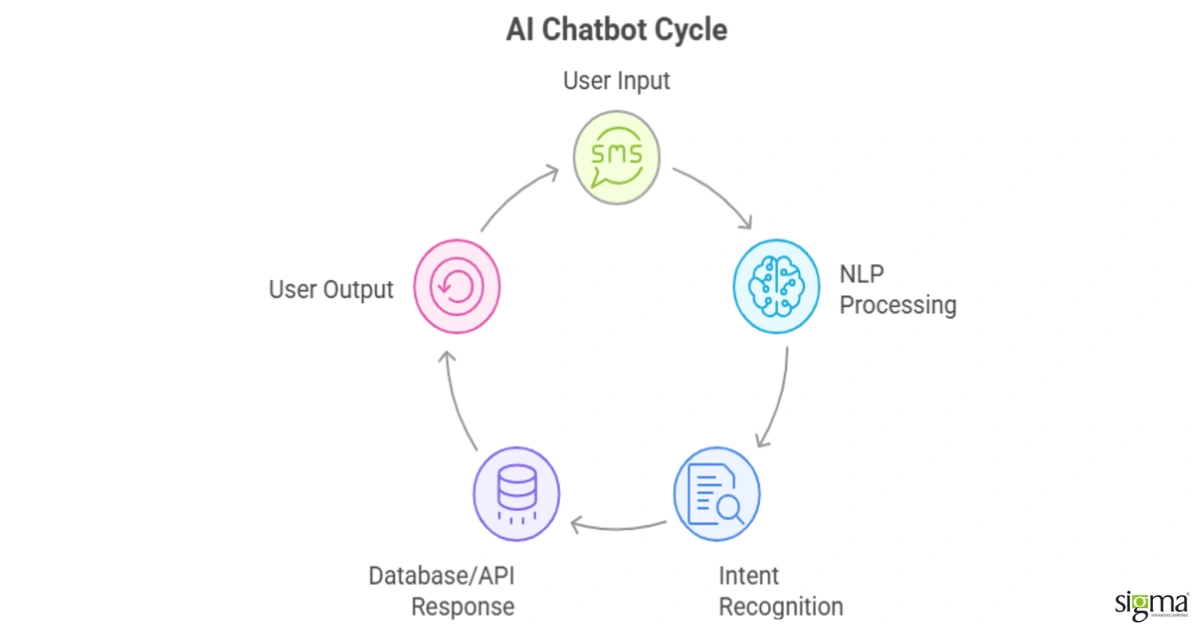
The Role of Machine Learning in Chatbots
Machine learning is essential for creating chatbots that learn, adapt, and improve over time. Unlike rule-based bots, ML-powered chatbots analyze past conversations to better understand user intent and context. This continuous learning helps them provide more accurate, personalized responses and handle complex queries.
Key benefits of machine learning in chatbots include:
- Adapting responses based on user behavior.
- Recognizing patterns to predict user needs.
- Improving accuracy with more interaction data.
- Supporting multilingual and personalized conversations.
For example, a customer support chatbot can learn common issues and suggest solutions faster, enhancing user experience and reducing human workload.
AI Virtual Assistants vs. Chatbots: Understanding the Difference
AI virtual assistants and chatbots both use conversational AI but serve distinct purposes and complexities. Chatbots typically follow scripted flows to handle specific tasks like answering FAQs or booking appointments. They excel in predictable, quick interactions but often feel robotic.
In contrast, AI virtual assistants leverage advanced NLP and machine learning to manage complex, ongoing tasks. They adapt to user behavior, provide personalized support, and can integrate with multiple systems for broader functionality.
- Feature
- Interaction Style
- Complexity
- Use Cases
- Learning Ability
- Chatbot
- Scripted, task-specific
- Simple to moderate
- Customer FAQs, scheduling
- Limited
- AI Virtual Assistant
- Adaptive, multi-tasking
- Advanced, context-aware
- Workflow automation, insights
- Continuous learning
For example, a chatbot may answer product questions, while a virtual assistant can manage your calendar, emails, and suggest priorities dynamically.
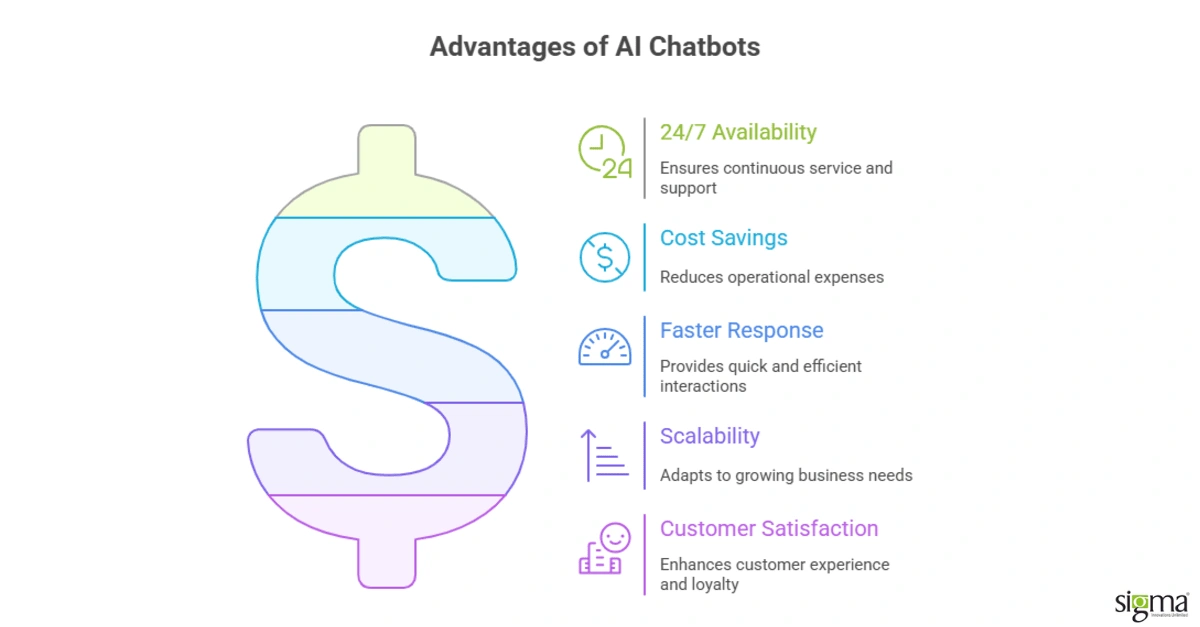
The Importance of Natural Language Processing (NLP) in Chatbot Development
Natural Language Processing (NLP) is the backbone of effective AI chatbots, enabling them to understand and respond to human language naturally. NLP breaks down user inputs by analyzing sentence structure, intent, and context, allowing chatbots to interpret queries accurately and generate relevant replies. This makes conversations feel more intuitive and less robotic.
Key benefits of NLP in chatbot development include:
- Understanding diverse user expressions and slang.
- Supporting multi-turn conversations for complex interactions.
- Enabling sentiment analysis to gauge user emotions.
- Supporting multiple languages for global reach.
For example, an ecommerce chatbot can use NLP to comprehend varied ways customers ask about product availability, improving response accuracy and customer satisfaction.
What is Natural Language Processing?
Natural Language Processing (NLP) enables computers to understand, interpret, and respond to human language naturally. It’s a key technology behind AI chatbots, allowing them to process user inputs like text or speech and generate meaningful, context-aware replies. NLP combines linguistics with machine learning to break down sentences, recognize intent, and handle nuances such as slang or tone.
An ecommerce chatbot could use NLP to grasp different ways customers ask about product availability, improving accuracy and making interactions feel human-like.
Key NLP Methods Used in AI Chatbots
Effective AI chatbots rely on several core NLP methods to understand and respond accurately to users. These techniques help break down complex human language into actionable data for the chatbot.
Key NLP methods include:
- Intent Recognition: Identifies the user’s goal or purpose, such as booking a ticket or asking about product availability.
- Named Entity Recognition (NER): Extracts specific details like dates, names, or locations from user input to provide precise answers.
- Sentiment Analysis: Detects the user’s emotions or tone to tailor responses empathetically.
- Tokenization and Stemming: Break down sentences into meaningful parts and reduce words to their base forms for better understanding.
For example, a travel chatbot uses intent recognition to detect a flight booking request and NER to extract travel dates and destinations, enabling smooth, contextual conversations.
Read the blog How AI and NLP Are Revolutionizing Clinical Decision-Making
Planning Your AI Chatbot: Defining Purpose and Scope
Defining your chatbot’s purpose and scope is the crucial first step to building an effective AI chatbot. Clarify what tasks it will handle – such as answering FAQs, qualifying leads, or processing orders – and who the target users are. This focus guides your design, technology choices, and conversation flow, ensuring the chatbot aligns with your business goals.
Key considerations include:
- Identifying primary chatbot functions and limitations.
- Understanding user needs and expectations.
- Setting measurable goals to evaluate success.
For example, a customer support chatbot might automate responses to common inquiries like order tracking, freeing human agents for complex issues. Clear purpose and scope prevent feature creep and help maintain a user-friendly experience.
Setting Clear Objectives for Your Chatbot
Setting clear, measurable objectives is essential to ensure your chatbot delivers real value. Begin by defining what you want your chatbot to achieve – whether it’s reducing customer wait times, increasing lead generation, or automating order processing. Clear goals help focus development and guide performance evaluation.
Key steps to define objectives:
- Identify primary use cases and user needs.
- Set specific, measurable outcomes (e.g., 30% reduction in support tickets).
- Align chatbot goals with broader business KPIs.
- Plan for scalability and future enhancements.
For example, a retail chatbot might aim to handle 50% of FAQs autonomously, freeing agents for complex queries. This clarity prevents scope creep and ensures your chatbot stays aligned with strategic priorities.
Identifying Your Target Audience and Use Cases
Clearly identifying your target audience and their needs is crucial for building an effective AI chatbot. Start by analyzing who will use your chatbot – consider demographics like age, location, and tech-savviness, along with their main problems or goals. This helps tailor your chatbot’s language, tone, and features for maximum engagement.
Common chatbot use cases include:
- Customer support for quick issue resolution.
- Lead qualification and sales assistance.
- Appointment scheduling and reminders.
- Providing product recommendations.
For example, a retail chatbot targeting busy shoppers can offer personalized deals and fast answers to product questions, boosting conversions and satisfaction. Defining precise use cases ensures your chatbot delivers real value and aligns with user expectations.
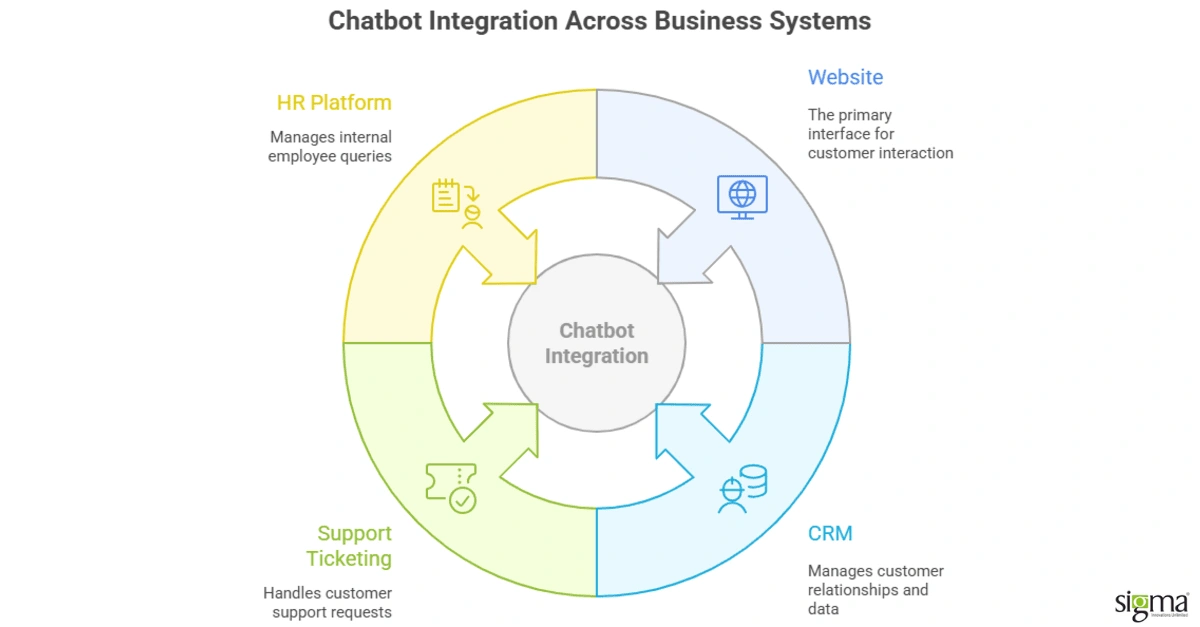
Choosing the Right Tools and Platforms for Chatbot Development
Selecting the right tools and platforms is crucial for building an effective AI chatbot that fits your needs and skill level. Consider factors like ease of use, integration capabilities, supported channels, and pricing. For beginners, no-code platforms offer drag-and-drop interfaces and seamless integration with social media and CRM systems. Developers seeking customization might prefer open-source frameworks, which allow deeper control and advanced AI integration.
Key considerations when choosing a platform:
- User-friendly design tools for fast prototyping.
- Multi-channel deployment (e.g., Facebook Messenger, WhatsApp, websites).
- Integration with third-party services like CRM or analytics.
- Pricing models that fit your budget and scale.
For example, many chatbots support Instagram and Facebook messaging with built-in CRM features, making it ideal for marketing-focused chatbots.
When to Consider Professional Chatbot Development Services
Professional chatbot development services become essential when your business needs advanced, scalable, and highly customized AI solutions. As customer interactions grow or require complex understanding – such as sentiment analysis, personalized recommendations, or multi-channel integration – expert developers can design chatbots that go beyond simple scripted responses.
Consider hiring professionals if you:
- Need a chatbot that handles unstructured conversations and learns over time.
- Require integration with CRM, payment gateways, or enterprise systems.
- Want to ensure data security and compliance with regulations.
- Aim for a seamless user experience with natural language understanding.
- Lack in-house technical expertise to build and maintain AI-driven bots.
For example, ecommerce businesses benefit from professional AI chatbots that provide 24/7 personalized support, increasing sales and customer satisfaction while reducing operational costs.
Step-by-Step Guide to Building Your AI Chatbot
Building an AI chatbot involves clear planning, selecting the right tools, and systematic development. Start by defining your chatbot’s purpose and target users, which shapes your design and technology choices. Next, choose a platform – open-source options like Botpress offer customization, while no-code tools simplify setup.
Follow these core steps:
- Define scope and objectives clearly.
- Design conversational flows with natural language understanding.
- Select AI models (e.g., GPT-4) and integrate them.
- Train your chatbot with relevant data.
- Connect your bot to platforms like websites or messaging apps.
- Test and refine responses for accuracy.
- Monitor performance and update regularly.
For example, using Botpress’s Autonomous Nodes lets your bot decide when to use scripted flows or AI-generated replies, enhancing user experience.
Step 1 – Setting Up Your Development Environment
Setting up a solid development environment is the essential first step to building your AI chatbot efficiently. Begin by choosing a programming language like Python or JavaScript, which are widely supported for AI and chatbot frameworks. Next, install key tools such as code editors (VS Code is popular), package managers (npm or pip), and version control (Git).
Don’t forget to create a .env file in your project directory to securely store sensitive data like API keys and connection strings – this keeps your credentials safe and separate from your codebase.
A simple checklist for your setup:
- Choose language and install runtime (Python/Node.js)
- Set up code editor and Git
- Create .env for secrets management
- Install SDKs and CLI tools for your AI platform
This foundation ensures smooth development and easy collaboration as you build your chatbot.
Step 2 – Designing the Chatbot Conversation Flow
Designing an effective chatbot conversation flow is key to delivering smooth, user-friendly interactions that meet your chatbot’s goals. Start by mapping out the user journey from greeting to resolution, ensuring clear entry points and satisfying end states. Use quick replies – clickable options that guide users without typing – to simplify navigation and reduce friction.
Focus on creating natural, intuitive dialogues that adapt to user responses and include fallback options for unclear inputs. For example, a support chatbot might ask step-by-step questions to diagnose an issue, then offer a human handoff if needed. Regularly test and refine flows based on real user data to keep conversations relevant and efficient.
Key tips for designing flows:
- Define clear user goals and paths.
- Use menus and buttons for easy navigation.
- Plan for multi-turn dialogues and fallback responses.
Step 3 – Implementing Natural Language Processing
Implementing Natural Language Processing (NLP) is crucial for making your chatbot understand and respond like a human. Key NLP tasks include tokenization (breaking text into words), intent recognition (identifying user goals), and named entity recognition (extracting important details like dates or names). Training your chatbot on relevant datasets improves its ability to interpret varied expressions and slang.
Here’s a simple approach to get started with NLP:
- Install necessary NLP libraries.
- Preprocess user inputs with tokenization and stemming.
- Use intent recognition models to classify queries.
- Extract entities for precise responses.
- Incorporate sentiment analysis to tailor replies empathetically.
For example, a retail chatbot can detect when a user asks about “return policy” and respond with the correct information, even if phrased differently.
Step 4 – Training Your Chatbot with Data
Training your chatbot with high-quality, relevant data is essential for accurate and natural conversations. Begin by collecting datasets that match your chatbot’s purpose – such as customer support transcripts, FAQs, or product information. Clean and label this data to help the AI recognize intents, entities, and context effectively.
Key steps to train your chatbot:
- Gather diverse, domain-specific conversational data.
- Preprocess and annotate data for intent and entity recognition.
- Fine-tune your AI model using this prepared dataset.
- Continuously update training data based on real user interactions.
For example, a retail chatbot trained on actual customer queries about returns and shipping can provide precise, helpful answers, improving user satisfaction and reducing support workload.
Step 5 – Testing and Refining Your Chatbot
Thorough testing and continuous refinement are vital to ensure your chatbot delivers accurate, seamless interactions. Start by evaluating technical performance metrics such as response accuracy, speed, and error rates. Use a golden dataset – sample conversations with known outcomes – to benchmark your chatbot’s understanding and reply quality.
Focus on these key testing areas:
- Functional Testing: Verify all conversation flows work as intended without dead ends or errors.
- Compatibility Testing: Ensure your chatbot performs well across devices, platforms, and integration points.
- User Experience Testing: Collect real user feedback to identify confusing responses or gaps.
Virtual assistants can be improved, for example, by integrating direct user feedback, enabling iterative updates that enhance reliability and satisfaction. Regularly analyze usage data and fine-tune your chatbot’s training prompts to adapt to evolving user needs and maintain high-quality service.
Step 6 – Deploying Your Chatbot to Your Platform
Deploying your chatbot effectively ensures it reaches users smoothly and performs reliably across channels. Begin by selecting the right hosting environment—cloud platforms like AWS, Azure, or Google Cloud offer scalability and security, especially if your chatbot handles sensitive data. Whether you’re embedding chatbots on websites, integrating them with enterprise systems, or extending them across messaging platforms. Sigma helps containerize applications for smoother portability, establish robust pipelines for continuous integration and delivery, and ensure compliance with your hosting and traffic requirements.
Key deployment steps with Sigma’s expertise include:
- Designing deployment architecture that aligns with business needs and regulatory standards.
- Automating builds, testing, and updates through CI/CD pipelines to accelerate time-to-market.
- Embedding chatbots on websites or digital touchpoints to instantly engage visitors.
- Seamlessly integrating bots with messaging platforms and backend systems for unified experiences.
- Monitoring performance and user interactions post-launch to drive continuous improvement.
With Sigma’s support, your chatbot can evolve from a proof of concept into a production-ready solution that enhances customer journeys while maintaining operational efficiency.
Best Practices for Effective Chatbot Design and Maintenance
Designing and maintaining an effective chatbot requires ongoing attention to user needs and performance data. Start by deeply understanding your target audience to tailor the chatbot’s tone, personality, and features. Keep conversation flows simple and intuitive, guiding users step-by-step with clear menus and fallback options.
Regularly monitor chatbot metrics like containment rate and response accuracy to identify areas for improvement. Use real user feedback and conversation logs to refine responses and update training data, ensuring the chatbot evolves with customer expectations.
Don’t forget to implement seamless human handoffs for complex queries, maintaining a smooth user experience. This iterative approach maximizes chatbot effectiveness, improves customer satisfaction, and reduces manual workload.
- Understand user behavior and preferences
- Design clear, guided conversation flows
- Continuously analyze performance data
- Update and retrain chatbot regularly
- Provide easy human agent escalation
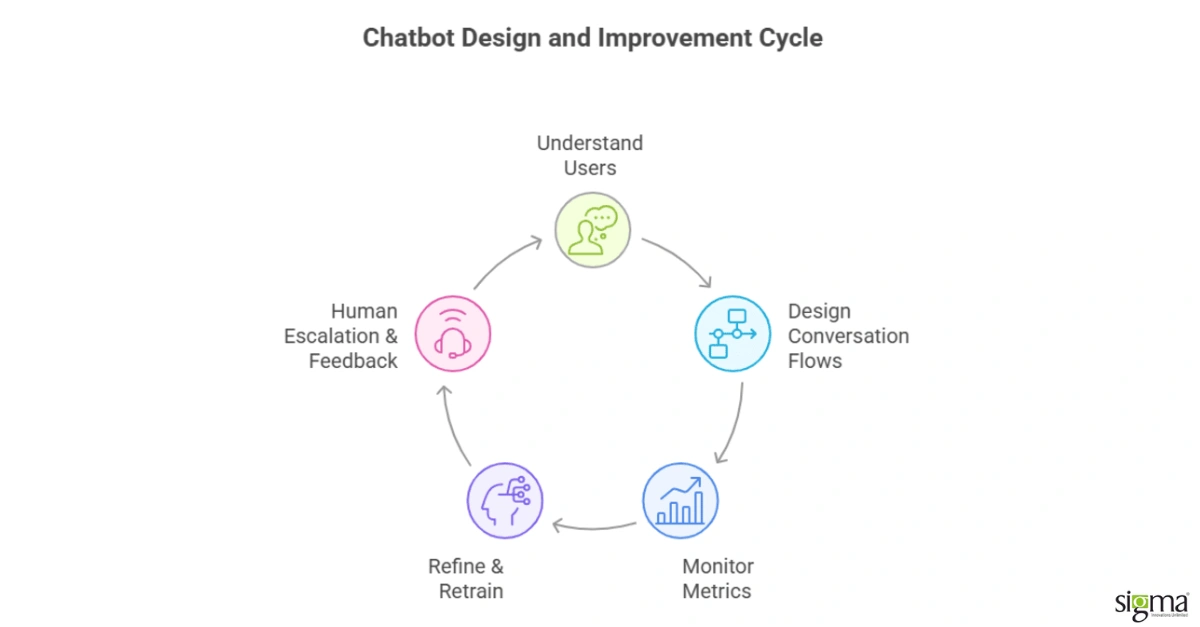
Designing Conversations That Feel Natural and Engaging
Creating chatbot conversations that feel natural and engaging is essential to user satisfaction and task success. Use casual, friendly language and incorporate emotional cues to make interactions relatable and less robotic. Guide users smoothly with clear prompts and quick replies, while allowing flexibility for open-ended responses.
Key tips for natural, engaging chatbot design:
- Use conversational language with varied sentence structures.
- Include empathy and acknowledgment to build rapport.
- Employ fallback responses that politely ask users to rephrase.
- Keep the dialogue flowing with relevant follow-ups or suggestions.
- Provide seamless handoffs to human agents when needed.
For example, instead of a robotic “I didn’t understand,” try “Sorry, I didn’t quite get that. Could you please rephrase it?” This invites users to continue without frustration, enhancing engagement and trust.
Monitoring Performance and Collecting User Feedback
Monitoring your chatbot’s performance and gathering user feedback are critical for continuous improvement. Track key metrics such as conversation volume, response accuracy, user sentiment, and resolution rates to understand how well your chatbot meets user needs. Conversation logs reveal patterns in user queries and highlight areas where the bot may struggle or cause frustration.
Implement a simple feedback system that allows users to rate responses or flag issues after interactions. This direct input helps identify recurring problems quickly. The best chatbots use real-time feedback to refine answers and enhance user experience continuously.
Key actions to monitor and improve your chatbot:
- Analyze conversation metrics regularly
- Collect and review user feedback systematically
- Update chatbot training data based on insights
- Use sentiment analysis to gauge satisfaction
- Iterate chatbot responses for better accuracy
Updating and Scaling Your Chatbot Over Time
Regular updates and strategic scaling are vital to ensure your chatbot remains effective as user demands grow and evolve. With Sigma’s AI & ML expertise, businesses can continuously retrain chatbots using fresh datasets, improving accuracy and enabling the bot to handle new and complex queries seamlessly. Sigma also helps in monitoring critical performance metrics – such as response times, query resolution rates, and error patterns – so you can identify and resolve bottlenecks before they impact the user experience.
To scale efficiently with Sigma’s support, you can:
- Optimize infrastructure and architecture for high-performance chatbot deployments.
Looking to modernize your legacy systems? Opt for Sigma’s product engineering services - Implement queue management and asynchronous request handling to ensure smooth operation during peak loads.
- Integrate your chatbot seamlessly with CRM systems, analytics tools, and enterprise workflows to deliver a unified, end-to-end user experience.
- Leverage Sigma’s AI-driven insights to continuously fine-tune your bot for smarter, faster, and more personalized conversations.
Additional Resources and Next Steps for Businesses Aspiring to Develop Chatbots
To advance your chatbot development, having the right resources and a clear plan for your next steps is crucial. With Sigma’s expertise in Artificial Intelligence Development Services, you can gain build intelligent, scalable, and customizable chatbots tailored to real business needs. Sigma’s AI services enable you to design conversational flows, integrate advanced natural language processing, and deploy chatbots that enhance customer engagement while streamlining business operations.
Next steps to deepen your expertise with Sigma’s support include:
- Exploring how Sigma’s AI & ML services can help you prototype and scale chatbot solutions efficiently.
- Leveraging Sigma’s guidance to understand conversational AI best practices and advanced NLP techniques.
- Engaging with Sigma’s team to co-develop use cases and contribute to projects that offer real-world learning.
Conclusion: Start Building Your AI Chatbot Today
Building your AI chatbot is more accessible than ever with AI development services – start now to unlock its potential for your business or project. By clearly defining your chatbot’s purpose, selecting the right services that follow a structured development process, you can create a conversational agent that enhances user experience and automates key tasks.
Remember these quick tips to get going:
- Define clear goals and target audience.
- Choose a platform that matches your skills and needs.
- Design natural, engaging conversations.
- Train and test thoroughly before deployment.
- Monitor and update regularly to improve performance.
For example, even a simple customer support chatbot can save time and delight users by handling common queries instantly. Take the first step today, and watch your AI chatbot transform interactions and drive value.
You’ve read the guide—now build smarter!
Don’t just follow steps, master them. Leverage Sigma’s Artificial Intelligence Development Services to design, train, and deploy chatbots that scale intelligently. Collaborate with Sigma Today.
Frequently Asked Questions (FAQs)
1. What is the difference between a rule-based chatbot and an AI chatbot?
Rule-based chatbots follow predefined scripts and can only respond to specific commands or keywords. AI chatbots, on the other hand, use Natural Language Processing (NLP) and Machine Learning (ML) to understand intent, learn from past interactions, and generate dynamic, context-aware responses.
2. How long does it take to build an AI chatbot?
The timeline depends on complexity and scope. A simple chatbot using no-code tools can be built in a few hours or days, while a fully customized AI chatbot with NLP, ML, and third-party integrations may take several weeks to months.
3. Do I need coding skills to build an AI chatbot?
Not necessarily. There are several no-code or low-code options for beginners. However, coding skills are useful if you want to build advanced, highly customized chatbots with integrations and complex logic.
4. How do I train my chatbot to give accurate responses?
Training involves feeding your chatbot high-quality, domain-specific data (like FAQs, support transcripts, and product details). Using annotated datasets for intent recognition and continuous updates based on real user interactions will improve accuracy over time.
5. What are the best platforms to deploy AI chatbots?
AI chatbots can be deployed across multiple digital touchpoints, including websites, mobile apps, customer support portals, and messaging channels. They can also be integrated into enterprise systems for tasks like workflow automation, lead generation, and employee support.
